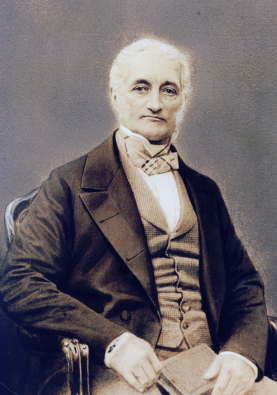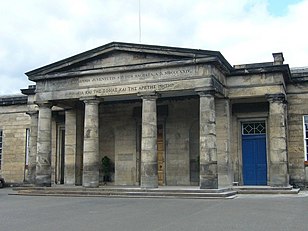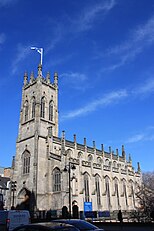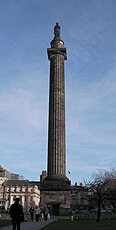
William Burn
William Burn FRSE (20 December 1789 – 15 February 1870) was a Scottish architect. He received major commissions from the age of 20 until his death at 81. He built in many styles and was a pioneer of the Scottish Baronial Revival, often referred to as the golden age of Scottish architecture.
For other people named William Burn, see William Burn (disambiguation).Life[edit]
Burn was born in Rose Street[1] in Edinburgh, the son of architect Robert Burn and his wife Janet Patterson. He was the fourth of their sixteen children.
He was educated at the High School in Edinburgh's Old Town. He started training with Sir Robert Smirke in London in 1808. This is where he worked on Lowther Castle with C.R. Cockerell, Henry Roberts and Lewis Vulliamy.[2]
After training with Smirke, Burn returned to Edinburgh in 1812. There, he established a practice from the family builders' yard. His first independent commission was in Renfrewshire. In 1812, he designed the exchange assembly rooms in Greenock. His father gave him the commission for a church in North Leith; this commission is what made his career and gave him a reputation.
In 1816, Burn entered a competition to complete Robert Adam's university.[3] He lost the competition to William Henry Playfair. Thenceforth, Burn started designing country houses.
In 1827, he was elected a Fellow of the Royal Society of Edinburgh, unusual for an architect, his proposer being James Skene.
In 1825, he took on a pupil, David Bryce. In 1841, they went into partnership together. Bryce ran the Scottish office, and Burn ran the English office, in Stratton Street. From 1844, he worked in London, where he took on his nephew John Macvicar Anderson as a partner.
In the 1830s, he was living and working at 131 George Street in the New Town.[4]
By 1850, the Scottish office was much more profitable, and the partnership ended.
Burn was a master of many styles. He was a pioneer of the Scottish Baronial Revival, with Helen's Tower (1848), Castlewellan Castle (1856) and Balintore Castle (1859).
Freemasonry[edit]
It has not been ascertained where Burn became a Freemason but he was the Grand Architect of the Grand Lodge of Scotland from 1827 to 1844 when his pupil, David Bryce, was named as 'joint' Grand Architect. Both served the Grand Lodge of Antient Free and Accepted Masons of Scotland, in that joint capacity, until 1849. Thereafter, David Bryce was Grand Architect in his own right until 1876.[5]
Death[edit]
Burn died in 1870, aged 80, at 6 Stratton Street in Piccadilly, London,[6] and is buried in Kensal Green Cemetery just on the edge of the path to the north-west of the Anglican Chapel.
William Burn had many pupils:





